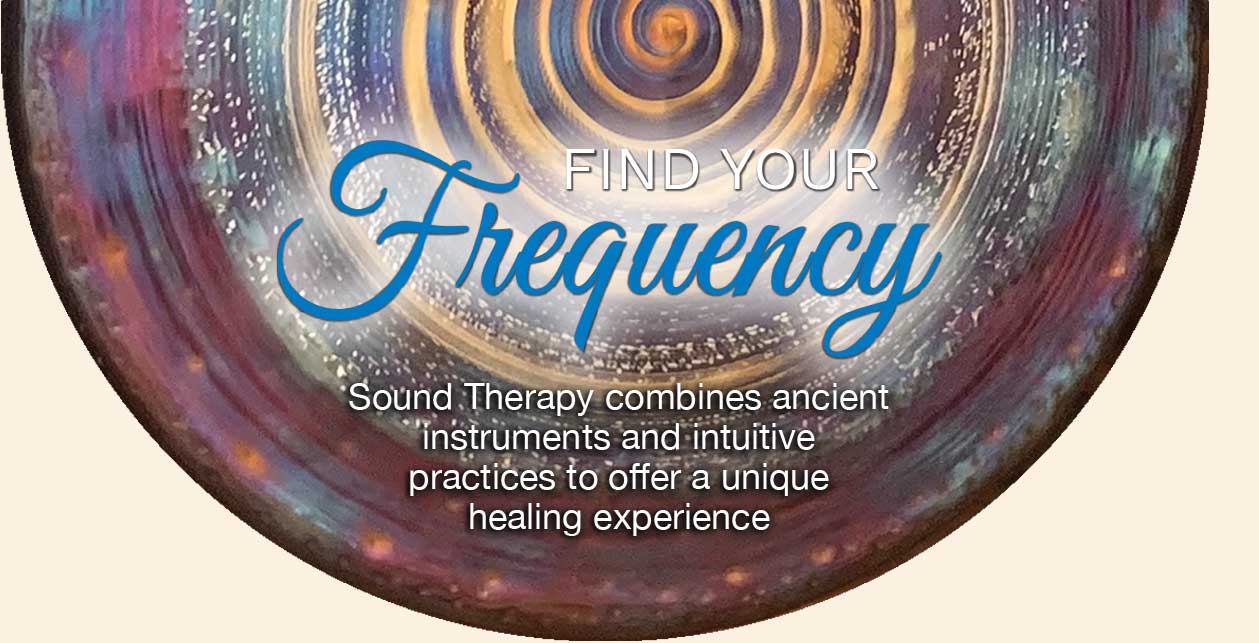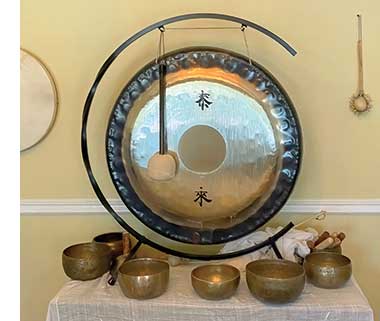
Sounds ignite powerful reactions within us, even in everyday life.
From the swell of emotion from a favorite song to a jolt of tension provoked by a passing siren, we are closely attuned to the cacophony of the world. Today, while life seems noisier than ever, Maine’s sound therapy practitioners use an arsenal of instruments to drown out the din and provide calm and healing to their patients.
Can sound therapy offer a balm to modern life? Research into the neuroscience of music therapy has identified several health benefits: boosting immune function, lowering anxiety levels, alleviating chronic pain, and even improving the health of premature babies. Sound therapy may be less clearly understood, but its patients find remedy in tone and vibration for both emotional and physical ailments.

Therapeutic gong with antique Tibetan singing bowls. Photo courtesy Joanne Liljeholm
At the end of a long driveway in Union, Jim Doble of Elemental Design hosts sessions from a recessed octagonal space, framed on one side by windows and the other by suspended gongs and chimes. A craftsman with a flair for everything from glass to wood to metal, Doble found his way into creating percussive instruments and sound therapy quite by chance more than 20 years ago.
“I went to a musical improvisation workshop and played a huge wooden xylophone,” he said. “I really enjoyed it, so I came home and messed around and made one – just like that,” he added with a laugh. He tinkered around with instruments until one day, while playing a combination of glass and slate instruments with a friend, Doble felt something. “I was playing one, he was playing the other,” he said. “Suddenly, there was this other sound coming out. I felt it affect me, affect my brain. And I was like – what was that?”
‘That’ might be the great humming resonance that washes over you during a sound therapy session. Doble invites his clients to lie in the center of the room and experience a soundscape that ebbs and flows, a sensation that provokes both physical and emotional responses. The experience is far more primal and transporting than simply listening. “It’s powerful,” says Doble. “There’s a substance to that sound; it really fills the room. It’s very visceral. It can be overwhelming.”

Jim Doble’s collection of suspended gongs, sourced from as far as Myanmar, are played to create a ‘soundscape.’ Photo courtesy Saisie Moore.
Doble’s primary instrument – a collection of 11 suspended gongs has diverse provenance, from the Myanmar Mountains to China, and some are even made in Doble’s workshop. “They all have their own sounds and personalities,” he says. In addition, he incorporates Tibetan singing bowls, wooden rattles, and tuning forks to produce vibrating tones on and around the body. The effect seems to both soothe and focus the mind. “I believe what matters is the progression of notes, the space between them, and their interaction with each other,” he says. “I sometimes refer to it as Sonic Meditation.” Individuals and groups can experience it themselves during a 90-minute session (from $80 per session).
Currently, there’s no official certification process yet for sound therapists. Most find their expertise through workshops and collectives, even the odd “gong conference” (a real event, according to Doble), where pioneers of the practice began converging during the 20th century to establish the method and science of sound therapy. Practitioners learn from these sound sages and follow intuition. Doble taps into Kundalini methods to trace energy down the spine and applies pressure at intervals with his tuning forks. A keen maker, he even makes “sound tanks”– repurposed propane tanks, allowing the user to climb inside and strike notches carved into the metal to astonishing soundscapes that vibrate and bounce around them. Doble hopes to bring his invention, “The Yellow Submarine” to the public, including those with hearing loss, to experience the strange and moving power of sound.

Joanne Liljeholm balancing chakras with Solfeggio Tuning Forks. Photo courtesy Joanne Liljeholm
Farther down south in Wells, Joanne Liljehom consolidates several decades of holistic practices designed to address a range of physical, emotional, and spiritual issues and restore balance. “My clients come to me for diverse reasons,” she says. “Often because they feel they are missing something, their treatment has reached a plateau with other providers, or they feel a stirring to look deeper into how their energy affects their physical bodies.”
A veteran massage and Reiki practitioner, Liljeholm began incorporating sound therapy a decade ago out of curiosity. She was immediately taken with the apparent results. “I was working with newborns and high-needs children at the time and it changed my world,” she says.
After establishing a studio sanctuary in Wells, Liljeholm began offering her unique combination of treatments, including elements of Massage Therapy, CranioSacral Therapy, Reiki, and Sound Healing. “I believe when the body is balanced energetically, we reignite our natural ability to heal at all levels,” she says. “When I work with each person, I listen deeply. I listen with my whole self. I do this through tuning forks to start with, and round out the deep work by playing alchemy singing bowls (composed of crystal, gems, and minerals fired at very high temperatures), or therapeutic gongs.”
The idea of sound therapy can appear abstract at its surface. According to Liljeholm, “Every cell in the body vibrates at its own unique frequency and each frequency makes a sound. Every energy center and organ has an ideal level. When the sound or frequency is off, it creates dysfunction. When we introduce the proper frequency back to the body, it drinks it in and starts the self-repairing process all on its own. Practitioners simply offer the sound and the body takes it from there.”
Escape from the overstimulation of everyday life might just be easier than you think. Instead of silencing the world around you, sound therapy conjures a sonic landscape that promises to refocus your mind and offer respite from the noise.
|
Public Baths At-Home Immersion Online Resources The traditional Tibetan singing bowl, a feature of many sound therapy sessions, can be bought for personal use. Bowls of different sizes are available at Mexicali Blues and online. Classes |
Story by Saisie Moore. Saisie is a freelance writer and editor based in Portland, Maine.




